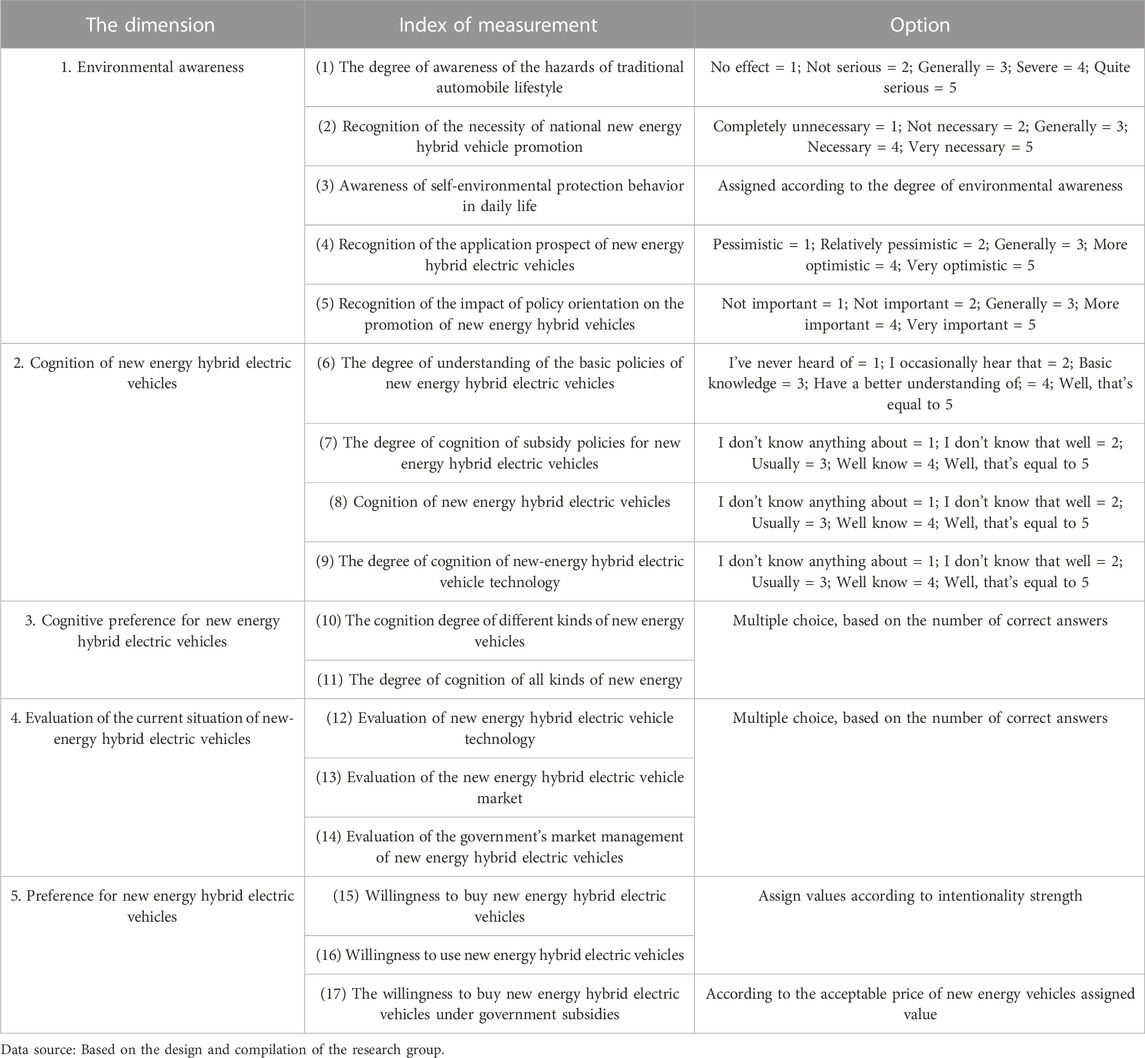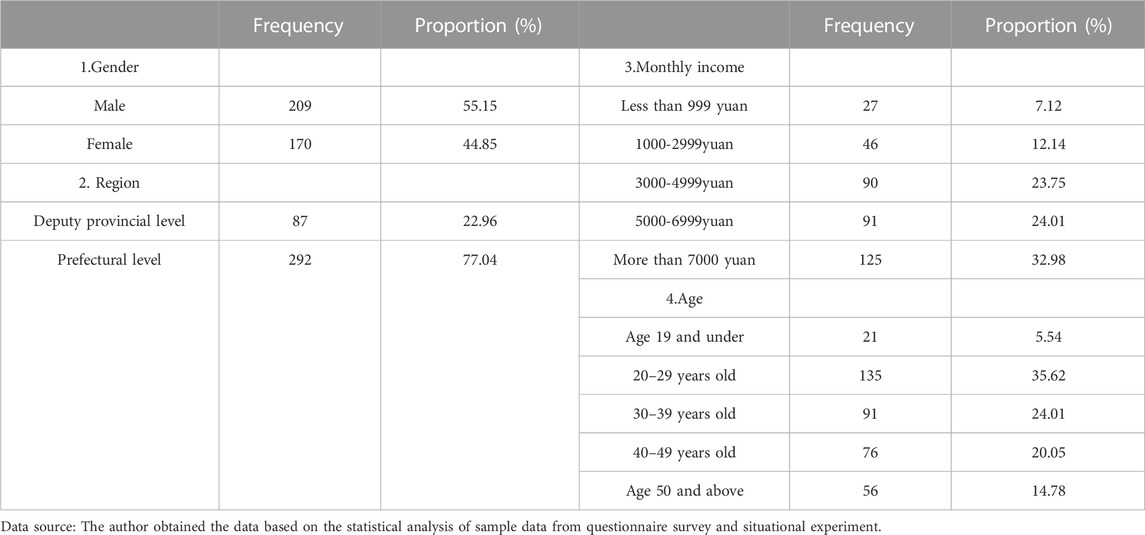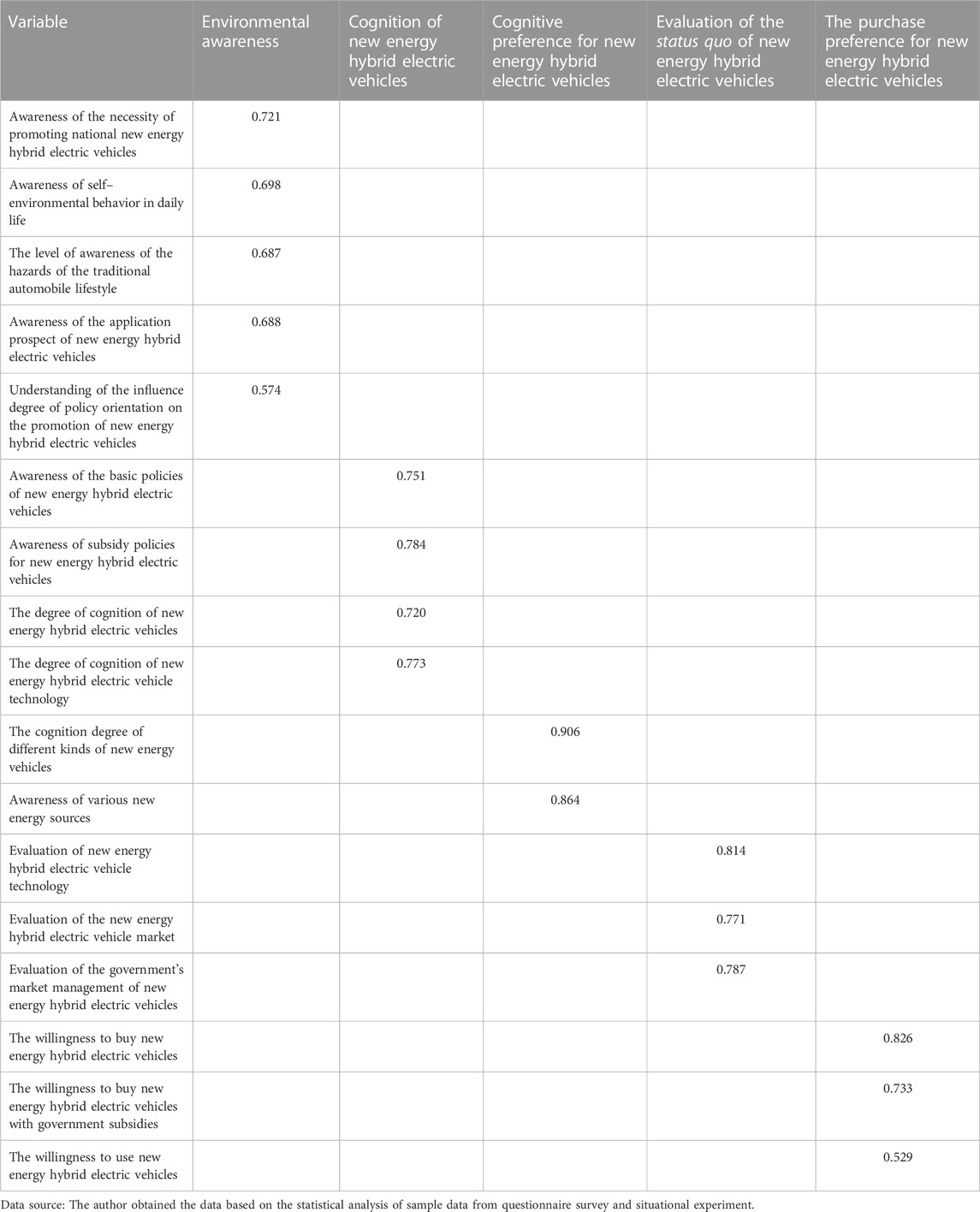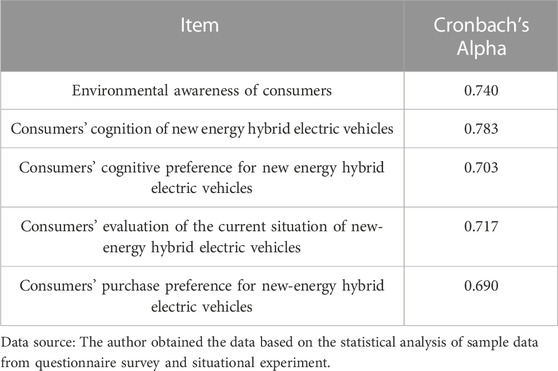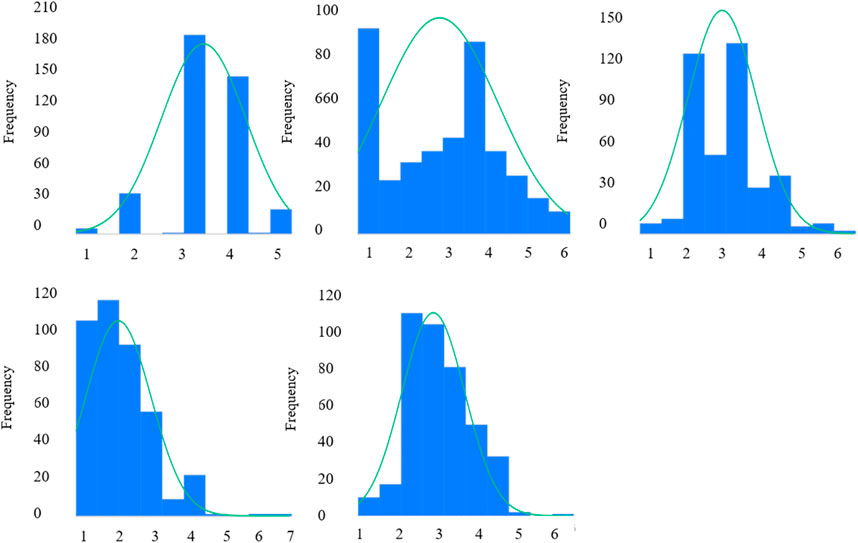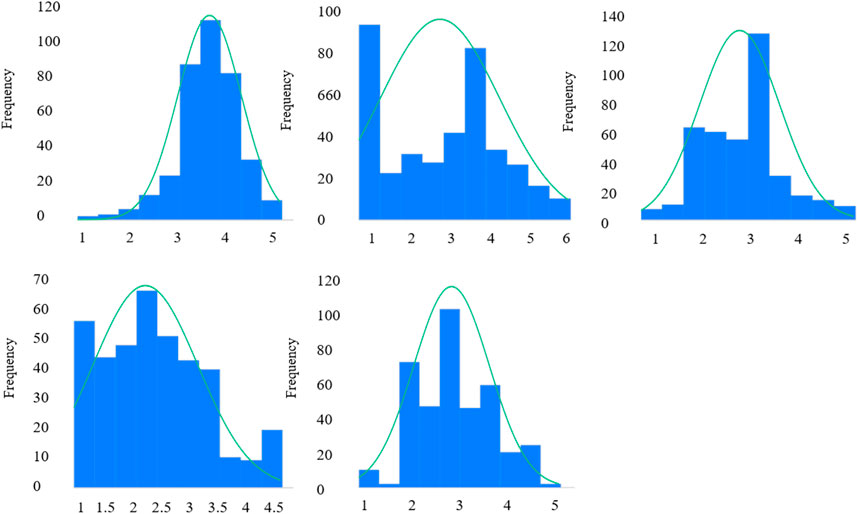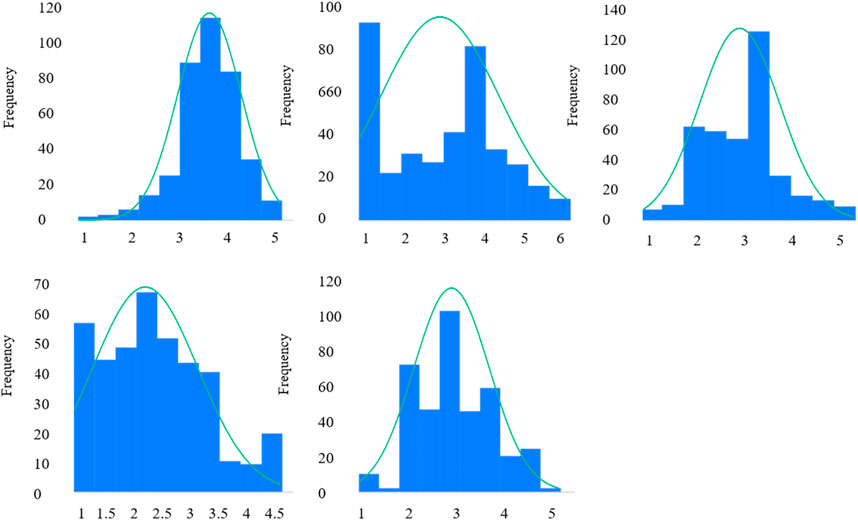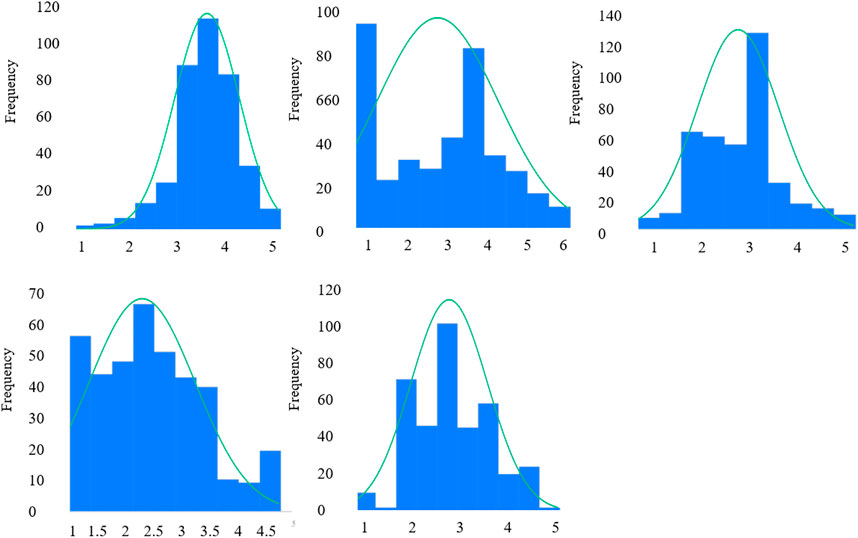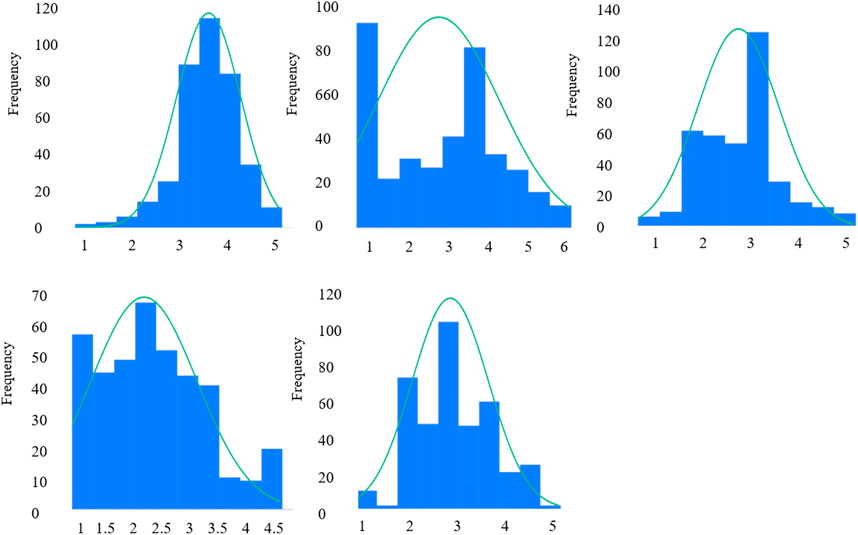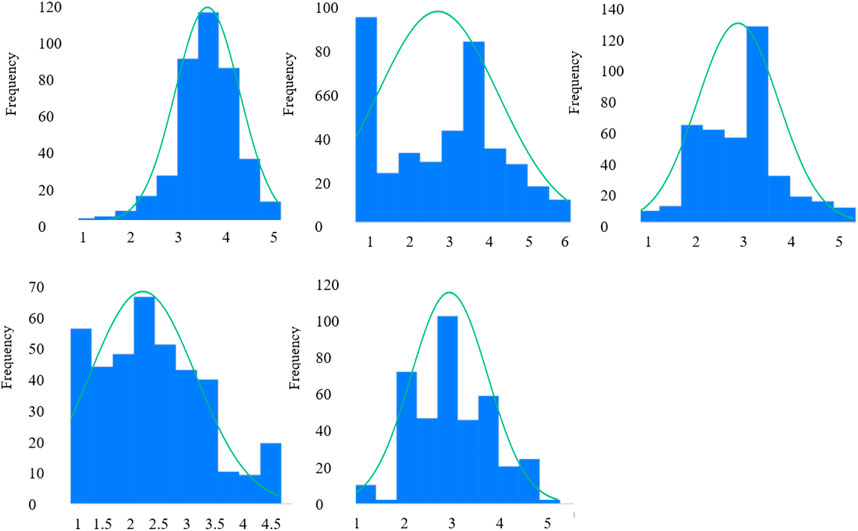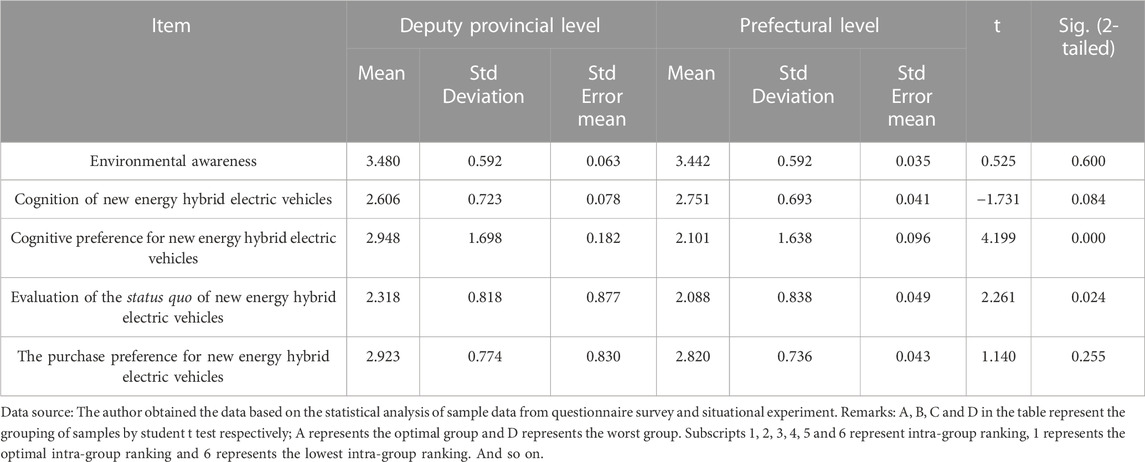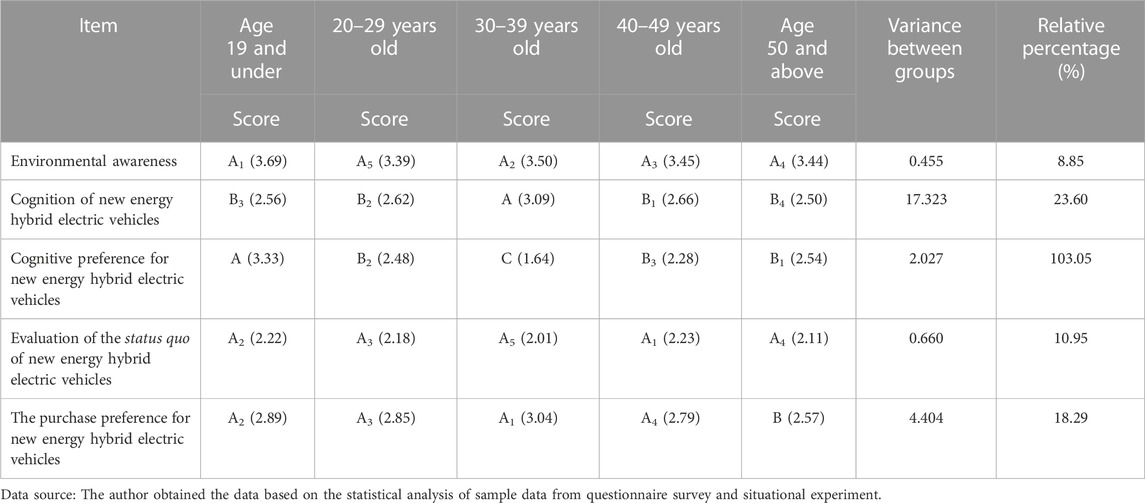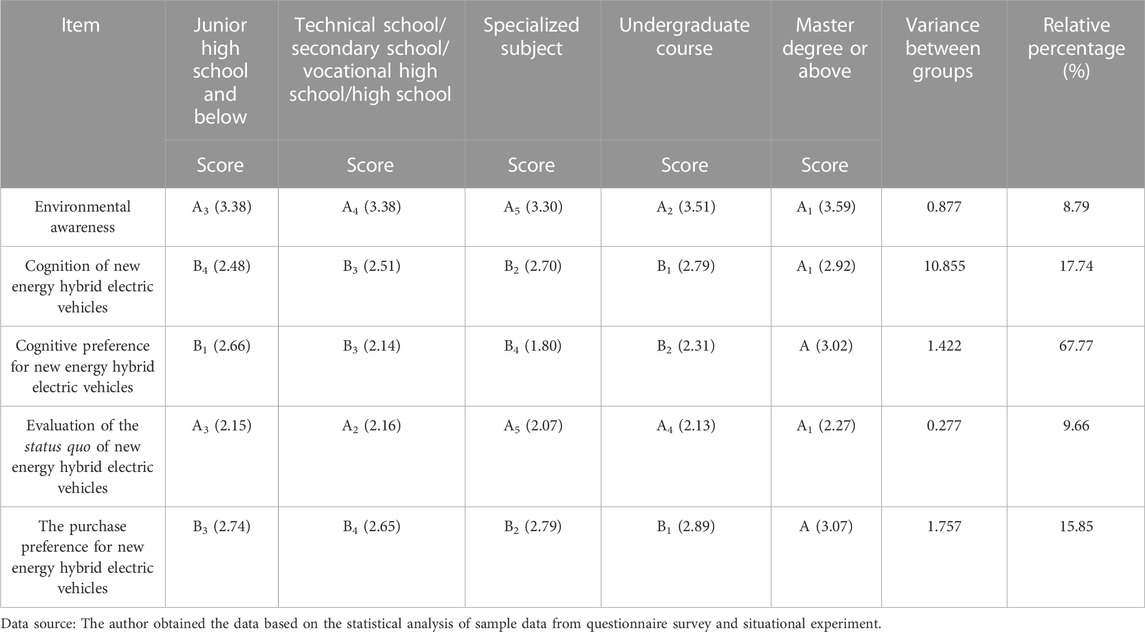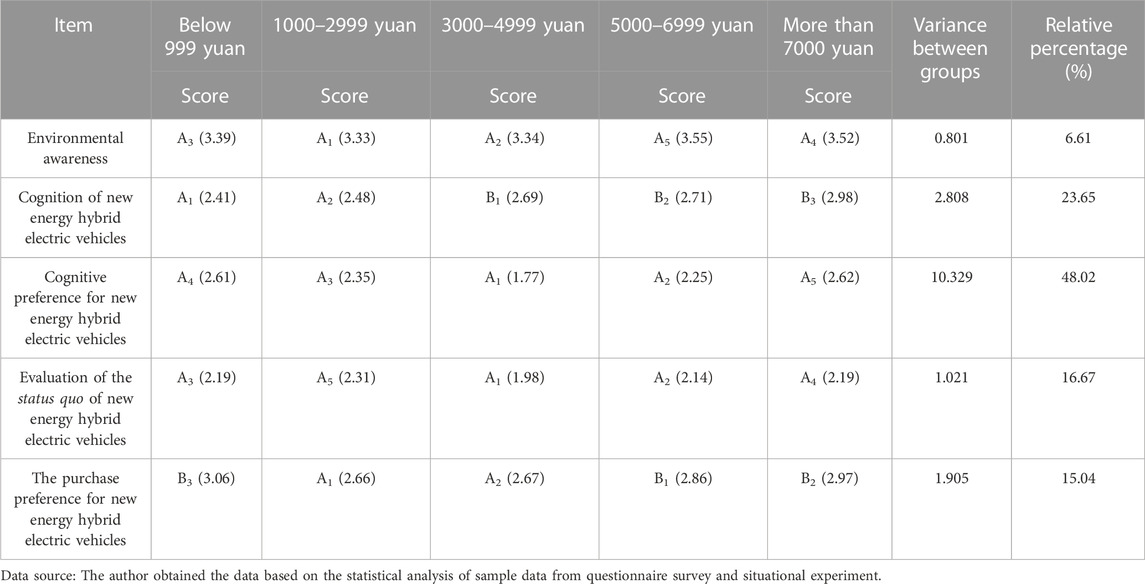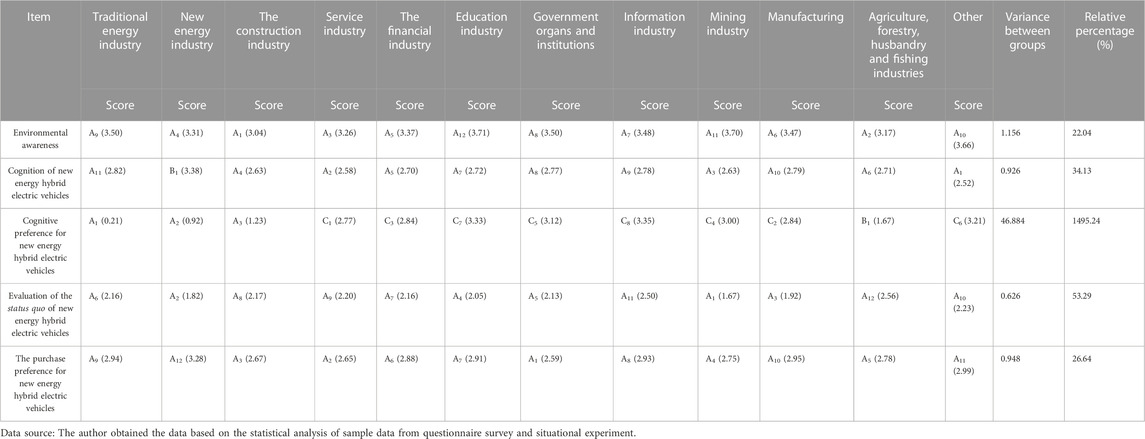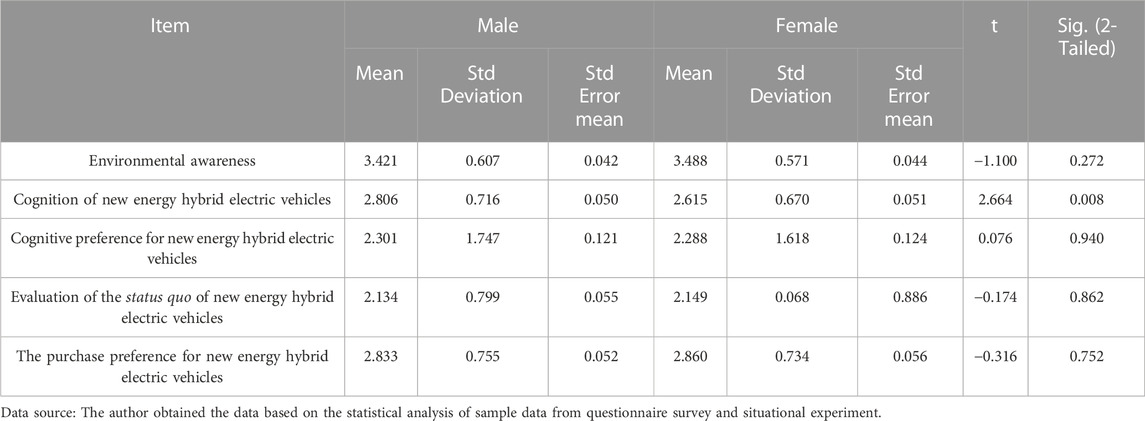An experimental study on the potential purchase behavior of Chinese consumers of new energy hybrid electric vehicles
- School of Economics and Trade, Guangdong University of Foreign Studies, Guangzhou, China
The automotive industry has paid close attention to the promising future of new energy vehicles, and the new energy hybrid electric vehicles that fall under this category are gradually entering the public eye. This paper uses the SPSS software to conduct an experimental study on the “purchase preference for new energy hybrid vehicles” and its influencing factors of different types of consumers in China, based on 379 questionnaires and the results of situational experiments conducted by the research group in 24 cities across the country. The findings are as follows: 1) Different categories of consumers have a large gap in their cognitive preferences for new energy hybrid electric vehicles; 2) There is little difference in “purchase preference for new energy hybrid electric vehicles” among different categories of consumers; 3) The improvement of education and income has a significant effect on promoting consumers’ “environmental awareness”; 4) Consumers’ perception of the government’s new energization policy is positive. Based on the preceding conclusions, this paper puts forward the policy recommendations to promote new energy hybrid electric vehicles.
1 Introduction
With the development of the global economy and the growth of energy consumption, global greenhouse gas emissions continue to rise, and the energy crisis is becoming more severe, arousing high attention of the entire society. China is a major energy consumer, accounting for more than a quarter of global energy consumption. Oil is indispensable as the primary energy source for traditional vehicles (ICEVs). According to statistics, cars account for 57% of China’s annual oil consumption. However, the massive loss of energy causes pollution and a scarcity of resources. Countries are developing and utilizing new energy to alleviate this problem, and vigorously developing new energy industry has become a global consensus. New energy has incomparable advantages over traditional energy because it is resource-rich and environmentally friendly. In recent years, new energy has gradually entered our lives, being used in a variety of fields, with new energy vehicles being a prime example. Various places have launched new energy vehicle implementation plans to boost the popularity of new energy vehicles since the promulgation of the New Energy Vehicle Production Enterprises and Product Access Management Rules in 2009. The introduction of new energy hybrid electric vehicles aided the development of the new energy vehicle industry. New energy hybrid electric vehicles maintain the benefits of energy conservation and low emissions while partially addressing the issues of insufficient charging infrastructure and limited driving range. And new energy hybrid electric vehicles are set to become a significant trend in the growth of the automotive industry. Although new energy hybrid electric vehicles have numerous advantages, there are still concerns like high prices and decreased subsidies. The key to promoting new energy hybrid electric vehicles has progressively been whether consumers are willing to purchase them. Consequently, conducting prospective experimental research on the probable purchasing behavior of Chinese new energy hybrid vehicles has significant theoretical and practical significance in order to present the appropriate policy recommendations.
2 Literature review
As the driving force behind the automobile industry’s future development, new energy vehicles bear the dual burdens of combating environmental pollution and the energy crisis, and their development status and prospects have piqued the interest of the government, businesses, and researchers. Domestic and international scholars are primarily concerned with the factors impeding the development and promotion of new energy vehicles. To begin with, most scholars agree that the cost, technical performance, and market acceptance of new energy vehicles are the most important factors to consider. Long et al. (2016) discovered that the primary factors influencing the booming sales of new energy vehicles are cost and charging infrastructure. According to the research of Xing and Wang (2010), the industrialization of essential technologies has not yet taken place, and the price of new energy vehicles is expensive. Palmer et al. (2018) investigated the market share and ownership costs of several vehicle models. Nodehi et al. (2022) suggested that battery life and energy efficiency will limit the development of new energy vehicles and that energy cost is one of the driving variables. Using the technology patent map, Xie et al. (2015) examined the technical data of three important new energy vehicle kinds in China: fuel cell, pure electric, and hybrid electric vehicles. Liu & Cheng (2014), who also studied new energy vehicle technology, made an in-depth analysis of energy consumption cost and business environment factors. Yuan et al. (2015) believed that the core technologies of new energy vehicles are not yet mature, and there are problems with the supply chain in the industrial sector and a small market share.
Furthermore, based on their research findings, various scholars have proposed other considerations that affect the development of new energy vehicles. Tang and Liu (2015) proposed infrastructure development as a factor to consider. Based on geospatial evidence from the United States, Kuming et al. (2016) investigated the effectiveness of government policies on the market sales of new energy vehicles. Meng et al. (2022) discovered that the dual-point policy could promote the development of the new-energy automobile industry. Qin and Xiong (2022) investigated the impact of non-financial policies on new energy vehicle innovation. In addition to the impact of policy factors, Fan et al. (2022) believed that consumer green preferences have an impact on the R&D and diffusion of new energy vehicles. Liu et al. (2020) investigated the strategic value and primary mode of battery reuse as significant challenges for the use of new-energy vehicle batteries.
The results of the available literature make it abundantly obvious that these various influencing variables still need to be addressed in order to promote the future diffusion of new energy cars. Additionally, these influencing variables will impact customer purchasing behavior to varying degrees. A portion of the literature is concerned with the outside forces that affect customer decisions. Chen et al. (2019) revealed that policies that are supportive can also indirectly improve customers’ perception of economy. The policy statement, according to Xiong and Wang (2020), would aid in boosting customers’ knowledge of the policy and purchase intent. Chan et al. (2014) looked into and contrasted how tax relief policies in China and the United States affected customers’ decisions to buy new energy cars. According to Wang et al. (2020), regional characteristics, in addition to vehicle efficiency and national regulations, impact customer buying behavior. Wang et al. (2013) demonstrated that the intrinsic character of goods, government policy incentives, costs, reference groups, and symbolic elements of products all have a substantial effect on the private purchase of new energy vehicles. Li and Guo. (2022), Xu et al. (2023) and Mi et al. (2018) respectively analyzed consumers’ purchasing behavior from the perspectives of safety and convenience of new energy vehicles, government subsidies and market acceptance of new energy vehicles, purchase intention, supporting facilities and economic cost.
In addition, some academics performed study from the viewpoint of actual consumers. Theoretically, Shen and Guo (2015) hypothesized that the vanity effect and the comparison effect may lead people to favor new energy cars. Consumer attitudes, subjective standards, and perceived behavioral control, according to Wang et al. (2021), play a crucial intermediary role in the acquisition of new energy cars. The results of Li et al. (2020) showed that consumers’ comprehension of and reactions to present and future industrial policies and policy combos are academically significant in the field of new energy cars. Du et al. (2018) indicated that low carbon subjective cognition and low carbon objective cognition have distinct mechanisms for influencing customer purchasing behavior. Hao et al. (2016) performed a questionnaire poll in seven Chinese towns and discovered that consumers’ monthly income, family vehicle possession, and the sustainability and convenience of vehicle use all had a significant influence on their buying behavior. Based on policies, vehicle performance, and consumer characteristics, Xian et al. (2022) concluded that tax exemption policies can improve consumers’ purchase intention, and that consumers with commuting needs have higher purchase intention. Zhao et al. (2022) discovered that personal norms and green self-identity are positively correlated with purchase intention. Li and Guo (2022), Li et al. (2021), Sun and Xu (2018), Wang et al. (2021), and other scholars have conducted detailed studies on different types of consumers’ consumption preferences from multiple perspectives.
At present, there are many literatures on new energy vehicles, but domestic researches on new energy hybrid electric vehicles are relatively few. While foreign scholars mostly start from the technical performance of new energy hybrid electric vehicles to study the improvement strategy of vehicles (Mesbahi T et al., 2014; Buccoliero G et al., 2019; Arevalo et al., 2020), research literature on the purchasing behavior of consumers of new energy hybrid electric vehicles is relatively rare.
In light of this, this paper analyzes 379 questionnaires from 24 cities across China using one-way ANOVA, independent sample t-test, and SNK test to reveal the potential purchasing behavior of different types of consumers (demographic variables) of new energy hybrid vehicles in China, as well as to provide a small supplement to the study of new energy hybrid electric vehicles. This paper aims to reveal the influence mechanism of different types of consumers’ potential new energy hybrid electric vehicle purchasing behavior, and to provide a foundation for relevant government departments to adopt incentive policies and measures to promote the consumption of new energy hybrid electric vehicles and to realize incentive policy measures for new energy vehicles.
3 Research methods and sample data
3.1 Research methods
The research methods used in this paper include literature review, questionnaire survey, situational experiment and statistical analysis.
(1) Literature review: This paper continues to track the frontier dynamics of domestic and international research on the purchase behavior of new energy hybrid vehicles through in-depth mining and analysis of relevant literature. Simultaneously, it seeks entry points for future research based on the current situation and scarcity of research on the consumption of new energy hybrid vehicles in China.
(2) Questionnaire survey: From the five dimensions of consumers’ “environmental awareness,” “cognition of new energy hybrid electric vehicles,” “cognition preference for new energy hybrid electric vehicles,” “evaluation of the current situation of new energy hybrid electric vehicles” and “purchase preference for new energy hybrid electric vehicles,” this paper adopts the questionnaire survey to measure the relevant variables. The questionnaire is filled out by the respondents in the selected locations of the sample cities in accordance with the random principle to ensure the reliability of the questionnaire data.
(3) Scenario experiment: In the absence of actual payment, consumers’ “new energy hybrid electric vehicle purchase behavior” may be affected by such factors as industry, income level, age, region, education level and other similar factors, thus compromising the reliability of the study. This paper introduces the scenario experiment method for hypothetical measurement. In this experiment, paired samples are collected after consumers complete the questionnaire and they filled out the questionnaire one by one. The situational experiment method adopted in this study is divided into two steps:
The first step is to select part of the questionnaire questions related to consumers’ purchase behavior of new-energy hybrid electric vehicles and set the score and proportion of each question (the five questions of industry, age, monthly income, residence and education level account for 20% each).
The second step is to mark the questions in accordance with the pre-designed questions, that is, to check the five options of industry, age, monthly income range, residence and education level, and to sum up the scores. Following the completion of the statistics, the consumers’ consumption capacity of new energy hybrid electric vehicles is estimated based on the calculated score.
(4) Statistical analysis: In this paper, SPSS statistical analysis software is used, and independent sample T-test and one-way ANOVA are adopted. The differences of 379 consumers from 24 cities in “environmental protection awareness,” “cognition of new energy hybrid electric vehicles,” “cognition preference for new energy hybrid electric vehicles,” “evaluation of the current situation of new energy hybrid electric vehicles” and “purchase preference for new energy hybrid electric vehicles” are quantitatively analyzed. Through the regression model, the moderating effect of policy variables on “new energy hybrid electric vehicle purchase behavior” is tested in order to reveal the potential law of Chinese consumers’ new energy hybrid electric vehicle purchase behavior.
3.2 Sample data
(1) Questionnaire design
This study adopts the form of structured interview questionnaire, in which 17 structured questions are designed and divided into 5 dimensions. They are “consumers’ environmental awareness,” “consumers’ cognition of new energy hybrid electric vehicles,” “consumers’ cognitive preference for new energy hybrid electric vehicles,” “consumers’ evaluation of the current situation of new energy hybrid electric vehicles” and “consumers’ purchase preference for new energy hybrid electric vehicles”. All the above 17 indicators are designed using five-point Likert scale (Table 1).
(2) Sample attributes
The data used in this paper are all from the Guangdong research group’s questionnaire and situational experiment data. Given the epidemic situation, this survey was carried out by combining online questionnaire distribution with an offline field survey. The sample data were collected from first-tier cities (Guangzhou, Shenzhen, Dongguan, Foshan), second-tier cities (Huizhou, Zhuhai, Zhongshan), third-tier cities (Shantou, Jiangmen, Zhanjiang, Chaozhou, Qingyuan, Zhaoqing), and fourth-tier cities (Maoming, Shaoguan, Shanwei), which are widely representative in terms of economic development and population distribution. Guangdong is a province with strong population mobility. Besides Guangdong Province, the data sources of the samples include Hunan Province (Changsha City, Chenzhou City, Changde City, Yongzhou City, Huaihua City, Yueyang City and Yiyang City), Hebei Province (Shijiazhuang City, Handan City, Xingtai City, Baoding City and Langfang City), Shanxi Province (Datong City, Yangquan City, Shuozhou City and Linfen City), Inner Mongolia City (Hohhot City), Heilongjiang Province (Hegang City, Jiamusi City and Suihua City), Jiangxi (Nanchang City, Xinyu City, Yichun City and Shangxiao City), Shandong (Jinan City, Zibo City, Zaozhuang City, Yantai City and Jining City), Henan (Zhengzhou City, Nanyang city and Shangqiu City), Guangxi (Liuzhou City), Sichuan (Chengdu City, Zigong City and Mianyang city) and Chongqing Municipality total 54 regions. In order to better explain the classification, the above regions were divided into sub-provincial and prefecture-level. Questionnaire data were collected in accordance with the random principle, and questionnaires were randomly distributed in densely populated places such as supermarkets, apartments, office buildings, and family homes in various cities. Our research group sent out a total of 400 questionnaires and recovered 383 questionnaires, for a recovery rate of 95.75%. Among them, 379 were valid, with an effective recovery rate of 98.96%. Males 209 account for 55.15% of the 379 samples; females 170 account for 44.85%. The distribution of population income and age in the regions involved in the sample is relatively balanced, which can reflect the basic characteristics of Chinese consumers and has good representativeness (Table 2).
(3) Reliability and validity test of data
After obtaining the data of the interview questionnaire, this paper uses SPSS 26.0 to conduct factor analysis on the 17 Likert scale indicators in the questionnaire. The results show that: ①The KMO value is 0.784, indicating that the data has good validity (Table 3). ②The 17 indicators are divided into 5 dimensions (Table 4). In addition, this paper analyzes the internal consistency of the data according to five different dimensions. The results show that the α value of the first dimension (consumers’ environmental awareness) is 0.740, the α value of the second dimension (consumers’ cognition of new energy hybrid electric vehicles) is 0.783, and the α value of the third dimension (consumers’ cognition preference for new energy hybrid electric vehicles) is 0.703. The α value of the fourth dimension (consumers’ evaluation of the current situation of new energy hybrid electric vehicles) is 0.717, and the α value of the fifth dimension (consumers’ purchase preference for new energy hybrid electric vehicles) is 0.690. Hence, the scale data exhibit good internal consistency (Table 5).
4 Test results and analysis
Based on the information gathered by the research team, this paper applied the one-way ANOVA SNK test (commonly known as the “Student’s t-test”) method using SPSS 26.0 software. The “environmental awareness,” “cognition of new energy hybrid electric vehicles,” “cognitive preference for new energy hybrid electric vehicles,” “assessment of the current situation of new energy hybrid electric vehicles,” and “purchase preference for new energy hybrid electric vehicles” are all conducted, respectively, among consumers in various regions, age groups, educational levels, income levels, genders, and occupations. In order to examine the significance of differences between several groups, an independent sample SNK test was conducted.
The paper performed the normality test on the sample data to confirm that the SNK test was feasible before performing the one-way ANOVA test. The findings demonstrate that the normal plot has a bell shape with a high center and a low end, which is generally recognized as a normal distribution. The histogram of the normality test for each group is displayed in Figure 1, Figure 2, Figure 3, Figure 4, Figure 5, Figure 6.
4.1 Analysis of different regions
According to the sub-provincial and prefectural level regions divided by 54 regions in the survey data, we first conducted SNK tests on the “purchase preference for new energy hybrid electric vehicles” of consumers in different regions and the four dimensions that affect the purchase preference for new energy hybrid electric vehicles (Table 6). The findings indicate that.
(1) The “environmental consciousness” of customers in sub-provincial and prefectural level locations varies just slightly. The terms “cognition of new energy hybrid electric vehicles,” “assessment of the status quo of new energy hybrid electric vehicles,” and “cognitive preference for new energy hybrid electric vehicles” all differ significantly. In addition to the cognition of new energy hybrid electric vehicles, the sub-provincial consumers are better than the prefecture level consumers in other four indicators. Consumers in the area have better economic backgrounds and more affluent lifestyles, which results in a sub-provincial level of economic development that is significantly higher.
(2) Consumers in sub-provincial areas have lower cognition of new energy hybrid electric vehicles. The sub-provincial level is more developed, and it is more responsible for leading the society’s new green trend. Furthermore, consumers in the region have more opportunities to interact with the new energy hybrid electric vehicle industry, but survey results show that consumers in the region have a poor understanding of all aspects of new energy hybrid electric vehicles. The government and other relevant departments should pay attention to this. All departments, in particular, must focus on policy guidance and the popularization of more relevant knowledge.
4.2 Analysis of different age groups
We conducted SNK tests on the “purchase preference for new energy hybrid electric vehicles” of consumers of different ages and the four dimensions that affect the purchase behavior of new energy hybrid electric vehicles (Table 7). The results show that.
(1) In contrast to the relatively small difference in “purchase preference for new energy hybrid electric vehicles,” there is a substantial difference between “cognition of new energy hybrid electric vehicles” and “cognitive preference for new energy hybrid electric vehicles” among all age groups. In terms of “cognitive preference for new energy hybrid electric vehicles,” there is a significant difference between the age groups of under 19 years old, 30–39 years old, and other age groups, with a difference of 103.05% between the group with the largest mean (under 19 years old) and the group with the smallest mean (30–39 years old) (significance level is 0.05). This demonstrates that there is a significant age difference in Chinese residents’ preferences for new-energy hybrid vehicles, and there is no positive correlation between age and cognitive degree, indicating that these preferences are more likely to be influenced by an individual’s personal library of pertinent information. Although there are substantial variations in group cognition, most individuals have a high level of environmental awareness. Age-related preferences for new energy hybrid electric cars are thus consistent across age groups.
(2) Young and middle-aged individuals (30–39 years old) have the lowest opinion of the status quo of new energy hybrid electric vehicles, but have the highest purchase preference. At this stage, the group personalities tend to be mature, rich in life and work experience, and are more concerned with social issues. At present, there are numerous difficulties and impediments to the widespread adoption of new energy hybrid electric cars. This group is concerned about the development prospects of new energy hybrid electric vehicles, but they have a greater awareness of the environment and social responsibility, which makes them more willing to purchase new energy hybrid vehicles.
(3) Young individuals (20–29 years old) have the weakest environmental consciousness. Young people have completed basic school requirements or even more advanced coursework. They are commonly highly educated and generally have a strong sense of responsibility to society. The unexpected nature of the poll results, however, should prompt societal reflection and increased attention from the government, schools, and other pertinent agencies. Measures should be taken to address the causes in addition to examining the root reasons.
4.3 Analysis of different educational levels
We conducted SNK tests on the “purchase preference for new energy hybrid electric vehicles” of consumers with different education levels and the four dimensions that affect the purchase preference for new energy hybrid electric vehicles (Table 8). The results show that.
(1) The “cognition of new energy hybrid electric vehicles,” “cognitive preference for new energy hybrid electric vehicles,” and “purchase preference for new energy hybrid electric vehicles” differ significantly among customers with varying levels of education. While there is no significant difference in cognition among groups of consumers with other education levels, consumers with the highest education level, a master’s or higher, have a significantly different cognition and cognitive preference for new energy hybrid electric vehicles compared to consumers with other education levels. This suggests that education has little effect on consumers’ cognition and preference for new energy hybrid electric vehicles. Individual subjective opinion, however, weighs more heavily. Across all age groups, this is also accurate. Consumers with the highest level of education of bachelor’s degree or above have greater cognition and cognitive preference for new energy hybrid electric vehicles, and consequently have higher purchase preference.
(2) There is little variation between groups in terms of “environmental awareness” and “evaluation of the current situation of new energy hybrid electric vehicles” among consumers with varying levels of education. In terms of “environmental awareness,” the mean gap between the highest (master’s degree or above) and the lowest (junior college) levels is 8.79%. The marginal difference between the categories suggests that Chinese citizens’ overall environmental protection awareness has increased. The highest education level (master’s degree or above) and the lowest education level (high school) are the mean values for “Evaluation on the current situation of new-energy hybrid electric vehicles,” and there is no discernible difference between the two. There is still a long way to go before new-energy hybrid electric vehicles are widely adopted in China due to the country’s residents’ apparent lack of trust in the market.
4.4 Analysis of different income levels
SNK test was conducted on the “purchase preference for new energy hybrid electric vehicles” of consumers with different income levels and the four variable dimensions that affect the purchase preference for new energy hybrid electric vehicles (Table 9). The results show that.
(1) “Cognition of new energy hybrid electric vehicles” is positively correlated with income level. Income significantly influences “cognition of new energy hybrid electric vehicles,” as shown in Table 9. The highest group’s mean number for “cognition of new energy hybrid electric vehicles” is 23.65% higher than the lowest group’s, and there is a variance of 2.808 between the two groups. Consumers with monthly incomes below 2999 yuan and those with monthly incomes above 3000 yuan are divided into two groups based on their “cognition of new energy hybrid electric vehicles” using the SNK test results from SPSS 26.0 at the significant level of 0.05. The mean value of “cognition of new energy hybrid electric vehicles” for consumers with a monthly income of more than 7,000 is the highest, while the mean value for consumers with a monthly income of less than 999 is the lowest. The bulk of the samples earning less than 999 yuan per month are college students with limited financial resources. It is usual for them to earn less than 1000 yuan per month. Furthermore, as living standards in China improve, as do inflation and other factors, the number of middle- and high-income people increases, and they are more interested in new energy and new technology, as well as having a strong ability to pay. Therefore, the cognition of new energy hybrid electric vehicles and their income level change positively.
(2) The largest disparity in “cognitive preference for new energy hybrid electric vehicles” is observed among customers of different socioeconomic levels. The difference between the highest and lowest mean values of “cognitive preference for new energy hybrid electric vehicles” is 48.02%, and the inter-group variance is also large compared with other indicators in the group, which is 10.329. Consumer groups have significant differences in cognitive preference for new energy hybrid electric vehicles, according to the inter-group classification of SNK test findings, with a monthly income of 3,000 yuan as the boundary. This reflects that when the average monthly income of consumers is between 3000 and 4999 yuan, their cognitive preference for new energy hybrid electric vehicles is relatively vague. Consumers with an average monthly income of less than 3000 yuan and more than 4999 yuan, on the other hand, have a comparable cognitive preference for new energy hybrid electric vehicles. From the standpoint of the development level of new energy hybrid electric vehicles in China, it should be the general trend to popularize the types of new energy and promote new energy vehicles, implement the policy of high-income group to purchasing new energy vehicles and implement the subsidy policy of low-income group consumers to purchasing new energy vehicles.
(3) Consumers with different income levels have small differences in “purchase preference for new energy hybrid electric vehicles” and “evaluation on the status quo of new energy hybrid electric vehicles,” and no significant differences in “environmental awareness.” As shown in Table 9, the relative difference between the mean values of the above indicators is 15.04%, 16.67%, and 6.61% respectively, and the variances between groups of different income levels are 1.905, 1.021, and 0.801. Except for environmental awareness, the mean value of each indicator and income does not change in the same direction. This indicates that increasing income or increasing subsidies has no obvious effect on improving residents’ environmental awareness, nor can it significantly affect consumers’ purchase preference for new-energy hybrid electric vehicles.
4.5 Analysis of different industries
SNK test was conducted on the “purchase preference for new energy hybrid electric vehicles” of consumers in different industries and the four variable dimensions that affect the purchase preference for new energy hybrid electric vehicles (Table 10). The results show that.
(1) Consumers in various industries differ the most in terms of “cognitive preference for new energy hybrid electric vehicles,” with consumers in the traditional energy industry having the least cognitive preference for new energy hybrid electric vehicles. The industry has a significant influence on “cognitive preference for new energy hybrid electric vehicles,” as shown in Table 10. The highest group’s mean value of “cognitive preference for new energy hybrid electric vehicles” is 1495.24% higher than that of the lowest group, and the variance between groups is 46.884. Consumers with different incomes were divided into three groups based on the SNK test results conducted by SPSS 26.0: traditional energy, new energy, and construction industry as one group, agriculture, forestry, husbandry, and fishery industry as a separate group, and other industries as one group. Consumers in the traditional energy industry have the lowest cognitive preference for new energy hybrid electric vehicles, indicating that more promotion and publicity of new energy types and new energy vehicle types, as well as attention to the transformation between traditional energy and new energy, is still required.
(2) Consumers from various industries have little difference in “cognition of new energy hybrid electric vehicles” (except new energy industry group). Table 10 shows that, except for the new energy industry group, there is no significant difference in perception of new energy hybrid electric vehicles across industries. The average value of “cognition of new energy hybrid electric vehicles” of the new energy industry group is higher, at 3.38, and the level of understanding of subsidy policies and technologies of new energy vehicles is deeper. Consumers in other industries, on the other hand, have little influence on their perceptions of new energy hybrid electric vehicles.
(3) Consumers engaged in construction industry have the lowest level of environmental awareness, followed by those in agriculture, forestry, husbandry and fishery. In terms of environmental awareness, consumers working in the construction industry have the lowest environmental awareness, which is closely related to the construction work itself. In the process of work, a large amount of construction waste will be generated, causing serious pollution to the environment. How to address both construction and environmental protection issues and recognize green construction is worthy of the attention and reflection of the concerned departments.
4.6 Analysis of different genders
SNK test was conducted on the “purchase preference for new energy hybrid electric vehicles” of consumers of different genders and the four variable dimensions affecting the purchase preference for new energy hybrid electric vehicles (Table 11). The results show that,
Consumers of different genders do not have significant differences in the four aspects of “environmental awareness,” “cognitive preference for new energy hybrid electric vehicles,” “evaluation of the current situation of new energy hybrid electric vehicles” and “purchase preference for new energy hybrid electric vehicles.” In addition to “cognitive preference for new energy hybrid electric vehicles,” female consumers outperform male consumers in the other three indicators, which may be due to women being more meticulous than men, having stronger environmental awareness, higher evaluation of new energy hybrid electric vehicles, and stronger purchase intention. However, male consumers perform better than female consumers in the indicators of “cognition of new energy hybrid electric vehicles” and “cognitive preference for new energy hybrid electric vehicles.” This may be because men pay more attention to novel things, and have a deeper understanding of the automobile industry and are more familiar with vehicle performance and related policy subsidies, which explains why the average value of “cognition of new energy hybrid electric vehicles” and “cognitive preference for new energy hybrid electric vehicles” of male consumers is higher than that of female consumers.
5 The moderating effect of government policy perception on the purchase preference for new energy hybrid electric vehicles
As rational consumers, “the purchase preference for energy hybrid electric vehicles” is influenced by their own “environmental awareness,” “cognition of new energy hybrid electric vehicles,” “cognitive preference for new energy hybrid electric vehicles,” “evaluation of the status quo of new energy hybrid electric vehicles” and other factors. National policies that are pertinent also have some influence on the acquisition of new energy hybrid electric vehicles. The government still lacks the necessary policies and procedures to develop the new energy hybrid vehicle industry as a result of the low level of new energy hybrid car development in China at the moment. In order to examine the effects of key government policies and their implementation efficiency on “new energy hybrid electric vehicle buying behavior,” this research employs regression analysis approach to study the moderating effect of policy variables on behavioral variables.
5.1 Design of policy variables by questionnaire
Three questions are included in the survey for this study to gauge participants’ perceptions and expectations of the government’s intervention policy. They are: 1) The role of the government in the formation of the buying atmosphere of new energy hybrid electric vehicles; 2) The proportion of government subsidies for new energy hybrid electric vehicles; and 3) Obstacles to the implementation of new energy hybrid electric vehicles in China. For questions (1) and (2), a value of “1”denotes a very low level of government participation, while a value of “5”denotes a high level of government participation. Question (3) is a multiple-choice question, and the research group assigns values according to the number of correct answers chosen by the respondents. These three questions were answered as part of a questionnaire by the experimenters. After analyzing the data from the questionnaire, the factor analysis revealed that there was no link between the policy variable and the other 15 factors, allowing it to be utilized as a moderating variable.
5.2 Verification of the adjustment effect of policy variables
First, average and standardize the sum of the scores of the three questions (independent variable), average and standardize the sum of the scores of “purchase preference for new energy hybrid electric vehicles” index (dependent variable), average and standardize the sum of the scores of “cognition of new energy hybrid electric vehicles”; Then, the standardized score of consumers’ perception of the government’s new energy vehicle policy and its implementation efficiency is multiplied by the average value of the standardized “cognition of new energy hybrid electric vehicles.” Finally, regression analysis was performed (Table 12). It can be seen from Table 12 that consumers’ “perception of the government’s new energy vehicle policy and its implementation efficiency” has a significant moderating effect between “cognition of new energy hybrid electric vehicles” and “purchase preference for new energy hybrid electric vehicles”, that is, the more standardized the government’s new energy vehicle policy, the stronger the “purchase preference for new energy hybrid electric vehicles”.
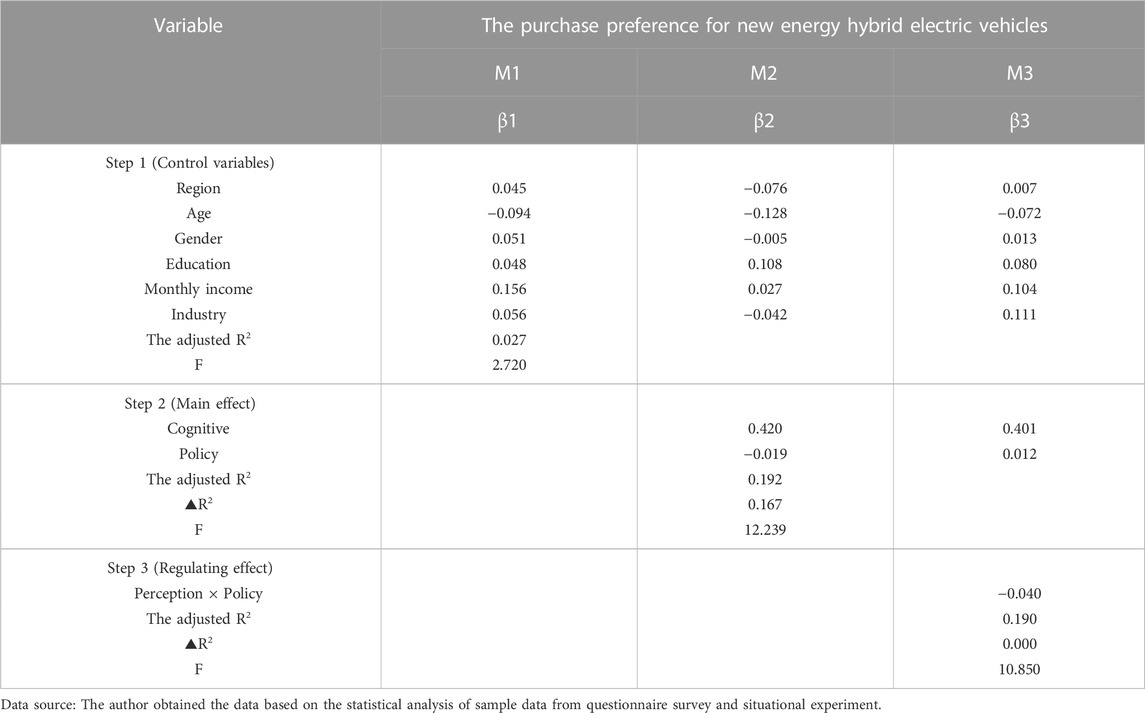
TABLE 12. Regression analysis of consumers’ perception of the regulatory role of the government’s new energy vehicle policy.
In order to more clearly describe the regulating effect of policy intensity on “purchase preference for new energy hybrid electric vehicles”, the method proposed by Aiken et al. (1991) was adopted in this paper. Depending on the mean value of policy intensity, one standard deviation was added or subtracted to the original data, and the original samples were converted into high policy intensity and low policy intensity. And do the regression equation of “cognition of new energy hybrid electric vehicles” and “purchase preference for new energy hybrid electric vehicles” respectively. Figure 7 show that no matter the policy intensity is high or low, the correlation coefficient between “cognition of new energy hybrid electric vehicles” and “purchase preference for new energy hybrid electric vehicles” is significant: β high policy = 0.437, p < 0.05; β low policy = 0.455, p < 0.05. There is no significant difference in the correlation coefficient between low and high policy intensity, indicating that consumers are unconcerned about the government’s new energy mixed policy and its implementation efficiency, resulting in a small difference between policy intensity and purchase preference.
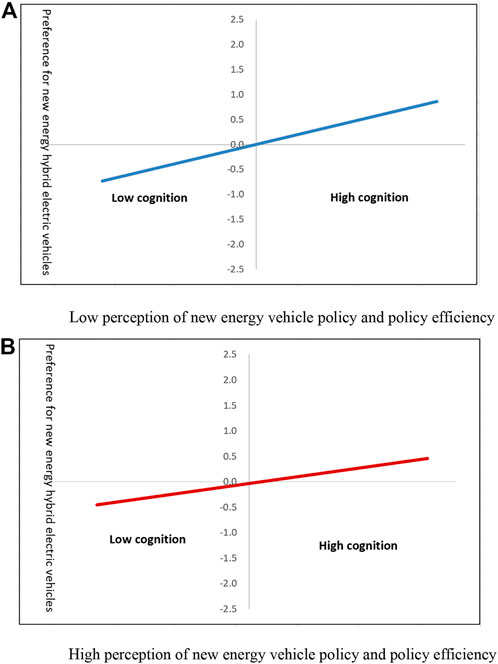
FIGURE 7. Schematic diagram of the moderating effect of consumers’ perception of low-carbon policies and the efficiency of policy implementation.
6 Conclusions and recommendations
6.1 Research conclusions
Through the above analysis and research, we reach the following conclusions.
(1) There is a significant disparity in “cognitive preference for new energy hybrid electric vehicles” among different categories of consumers. The relative difference of “cognitive preference for new energy hybrid electric vehicles” in different demographics is listed as industry, age, educational level and monthly income from highest to lowest. Industry is the largest within group variance of each demographic variable, followed by monthly income, age and educational background. ①The gap characteristics of “cognitive preference for new energy hybrid electric vehicles” of consumers in various demographic variables show that the high income, high education, adolescent (under 19 years old) male consumer groups in economically developed areas and engaged in new energy-related industries have a strong cognitive preference for new energy hybrid electric vehicles. ②The gap between industries in “cognitive preference for new energy hybrid electric vehicles” is the largest, which indicates that industry correlation has a more obvious role in improving “cognitive preference for new energy hybrid electric vehicles.” “Environmental awareness,” “cognition of new energy hybrid electric vehicles,” “evaluation of the current situation of new energy hybrid electric vehicles” and “purchase preference for new energy hybrid electric vehicles” are also the largest among the variables in the inter-industry gap, especially “evaluation of the current situation of new energy hybrid electric vehicles.” ③The difference value of consumers’ “cognitive preference for new energy hybrid electric vehicles” in each variable is the largest, indicating that each variable has a significant effect on “cognitive preference for new energy hybrid electric vehicles”.
(2) There is little variation difference in “purchase preference for new energy hybrid electric vehicles” among different categories of consumers. The relative difference of “purchase preference for new energy hybrid electric vehicles” in different demographics is ranked as industry, age, educational level and monthly income from highest to lowest, which is consistent with the ranking of “cognitive preference for new energy hybrid electric vehicles.” The differences in consumers’ “purchase preference for new energy hybrid electric vehicles” in various demographic variables show that the high-income, highly educated, middle-aged and young (30–39) female consumer groups in economically developed areas and engaged in new energy-related industries have strong purchase preference for new energy hybrid electric vehicles.
(3) The “environmental awareness” of consumers deserves attention. According to the analysis of different regions, there is little difference in environmental awareness between sub-provincial and prefectural levels. The analysis of different age groups displays that teenagers have the lowest environmental awareness; The analysis of different educational background and income reflects that the improvement of educational background and income plays a significant role in promoting the “environmental awareness” of consumers; The analysis of different industries indicates that consumers engaged in processing and manufacturing related industries have low environmental awareness; The gender-specific analysis illustrates that women are more environmentally conscious than men.
(4) Consumers’ “purchase preference for new energy hybrid electric vehicles” is affected by their perception of the government’s new energy vehicle policies, but the degree to which these policies are implemented does not significantly alter this preference. According to the empirical analysis, consumers’ “preference for new energy hybrid vehicles” will be stronger the more they believe the government plays a role in influencing the market for new energy hybrid vehicles, the higher the percentage of government subsidies, and the fewer obstacles to their adoption are. The government should concentrate on integrating the policy’s content into residents’ lives while vigorously implementing the policy in order to achieve the expansion of promotion efforts and put the policy in place as the implementation effect of the new energy vehicle policy of high and low intensity is not significant.
6.2 Policy suggestions
Based on the above research conclusions, this paper puts forward the following policy recommendations.
(1) Subdivide the consumption market for new energy hybrid electric vehicles and tap key customer groups for these vehicles. It is suggested to take high-income, highly educated, middle-aged and young female consumers (30–39 years old) in economically developed regions as the breakthrough point to spearhead the consumption strategy of new energy hybrid electric vehicle products. According to the differences in “purchase preference for new energy hybrid electric vehicles” among consumers in different regions, with different degrees, different ages, different incomes, and different occupations, different promotion strategies for new energy hybrid electric vehicles are formulated to stimulate the demand of various consumer groups for new energy hybrid electric vehicles.
(2) Increase the publicity and education about new energy hybrid electric vehicles and improve the environmental awareness of new energy hybrid electric vehicles among all groups of consumers. It can be seen from the above analysis results that consumers who are engaged in processing and manufacturing-related industries, are aged 20–29 years old, and live in economically developed areas have the lowest environmental awareness. The relevant government departments in China should carry out specific knowledge training and education for this group of people and take necessary assessment measures to improve consumers’ overall environmental awareness and awareness of new energy hybrid vehicles.
(3) Attach importance to the guidance of new-energy hybrid electric vehicle consumption and improve consumers’ cognition and preference for new-energy hybrid electric vehicle products. Publicize the new energy hybrid vehicle products through various media, such as television, the internet, community newspapers, posters, etc., and establish the leadership, organization, and publicity mechanisms for the consumption education and guidance of new energy hybrid vehicles, as well as guide the consumption behavior of new energy hybrid vehicles through various channels of government, enterprises, and consumers, in order to increase public awareness and preference for new energy hybrid vehicle products, and furthermore to lay a theoretical foundation for the possible purchase behavior in the later stage.
(4) Improve policies related to new-energy hybrid electric vehicles and improve the efficiency of their implementation. New energy hybrid vehicle consumption policies include financial (price) subsidies given by the government, the government’s promotion of new energy hybrid vehicle products and promotional measures, the government’s efforts to develop new energy hybrid vehicle-related systems, and other specific government policies to promote new energy hybrid vehicle consumption. In addition to the formulation of government policies, the efficiency of policy implementation at all levels of government also needs to be improved, through the establishment of a compensation mechanism for the development of new energy hybrid vehicles and the encouragement of local governments to develop new energy hybrid vehicle development plans with “local characteristics”, so that consumers can better perceive the degree of government attention and implementation efficiency and, thus, improve their enthusiasm to participate in the consumption of new energy hybrid vehicles.
(5) Enrich the subsidies for the purchase of new energy hybrid electric vehicles and increase the preferential efforts for new energy hybrid electric vehicles. The larger the government subsidy, the cheaper the initial purchase cost for customers, and the higher their buying preference. In other words, the more the government can influence people’s behavior through preference and the more ways it can do so, the more it can influence people’s behavior. Currently, the state only provides subsidies in the form of cash and does so exclusively using money obtained from the sale of private cars. The use of new energy hybrid vehicles in production, sales, and use, as well as a combination of taxes, plans, policies, and other methods to encourage and promote the development of new energy hybrid vehicles, are all possible measures the government can take to promote the development of new energy hybrid vehicles.
Data availability statement
The raw data supporting the conclusion of this article will be made available by the authors, without undue reservation.
Ethics statement
Ethical review and approval was not required for the study on human participants in accordance with the local legislation and institutional requirements. Written informed consent from the participants was not required to participate in this study in accordance with the national legislation and the institutional requirements.
Author contributions
Conceptualization, QG; Methodology, QG; Software and formal analysis, YL and LC; Writing—original draft preparation, QG, YL, and LC; Writing—review and editing, QG, YL, and LC; Supervision and funding acquisition, QG. All authors have read and agreed to the published version of the manuscript.
Funding
This research was supported by the National Social Science Foundation (21CJL007); the Humanities and Social Science Project of China’s Ministry of Education (20YJC790036); the Natural Science Foundation of Guangdong Province (2020A1515010629); the Basic and Applied Basic Research Project of Guangzhou (202102021185); Guangdong-Hong Kong-Macao Greater Bay Area Accounting and Economic Development Research Center Project, Guangdong University of Foreign Studies (YGAZD2022-04); Institute of City Strategy Studies Project, Guangdong University of Foreign Studies (JDZB202104); Pacific Island Countries Strategy Research Centre Project, Guangdong University of Foreign Studies (2021PIC003); Institute for African Studies, Guangdong University of Foreign Studies (HX-FZ2022-2); Asia-Pacific Security and Economic and Political Cooperation Research Centre Project, Guangdong University of Foreign Studies (YT2022001); Guangdong Postgraduate Education Innovation Project (2022XSLT027); Philosophy and Social Science Development Planning Project of Guangzhou (2021GZGJ07); Center for Translation Studies Project, Guangdong University of Foreign Studies (CTS202201).
Conflict of interest
The authors declare that the research was conducted in the absence of any commercial or financial relationships that could be construed as a potential conflict of interest.
Publisher’s note
All claims expressed in this article are solely those of the authors and do not necessarily represent those of their affiliated organizations, or those of the publisher, the editors and the reviewers. Any product that may be evaluated in this article, or claim that may be made by its manufacturer, is not guaranteed or endorsed by the publisher.
References
Aiken, L. S., West, S. G., and Reno, R. R. (1991). Multiple regression: Testing and interpreting interactions[M]. United States: sage.
Arévalo, P., Cano, A., and Jurado, F. (2020). Comparative study of two new energy control systems based on PEMFC for a hybrid tramway in Ecuador[J]. Int. J. Hydrogen Energy 45 (46), 25357–25377. doi:10.1016/j.ijhydene.2020.06.212
Buccoliero, G., Anselma, P. G., Bonab, S. A., Belingardi, G., and Emadi, A. (2019). A new energy management strategy for multimode power-split hybrid electric vehicles. IEEE Trans. Veh. Technol. 69 (1), 172–181. doi:10.1109/tvt.2019.2950033
Chan, K. H., Leng, M. M., and Liang, L. P. (2014). Impact of tax reduction policies on consumer purchase of new automobiles: An analytical investigation with real data-based experiments. Nav. Res. Logist. (NRL) 61 (8), 577–598. doi:10.1002/nav.21604
Chen, K., Ren, C., Gu, R., and Zhang, P. (2019). Exploring purchase intentions of new energy vehicles: From the perspective of frugality and the concept of “mianzi”. J. Clean. Prod. 230, 700–708. doi:10.1016/j.jclepro.2019.05.135
Du, H., Liu, D., Sovacool, B. K., Wang, Y., Ma, S., and Li, R. Y. M. (2018). Who buys new energy vehicles in China? Assessing social-psychological predictors of purchasing awareness, intention, and policy[J]. Transp. Res. Part F Traffic Psychol. Behav. 58, 56–69. doi:10.1016/j.trf.2018.05.008
Fan, R., Bao, X., Du, K., Wang, Y., and Wang, Y. (2022). The effect of government policies and consumer green preferences on the R&D diffusion of new energy vehicles: A perspective of complex network games. Energy 254, 124316. doi:10.1016/j.energy.2022.124316
Hao, Y., Dong, X. Y., Deng, Y. X., Li, L. X., and Ma, Y. (2016). What influences personal purchases of new energy vehicles in China? An empirical study based on a survey of Chinese citizens[J]. J. Renew. Sustain. Energy 8 (6), 065904. doi:10.1063/1.4966908
Kuming, C., Paul, M. S. C., and Seth, H. H. (2016). How are new-energy vehicle sales affected by government support? US geospatial evidence[J]. Економічний часопис-ХХІ 2016 (160), 14–24. doi:10.21003/ea.V160-03
Li, C., Ye, L. L., and Wang, L. P. (2021). Influence of new energy vehicle consumption promotion policies on potential consumers' purchase intention [J]. China Manag. Sci. 29 (10), 151–164. doi:10.16381/j.cnki.issn1003-207x.2019.1845
Li, D. Q., and Guo, Y. (2022). Research on consumers' cognition and purchase decision of new energy vehicles under the "dual carbon" target: Based on a survey in Wuhan City. Hubei Soc. Sci. 2022 (08), 55–65. doi:10.13660/j.cnki.42-1112/c.015926
Li, J. Z., Zhou, Y. P., Yu, D. K., and Liu, C. (2020). Consumers’ purchase intention of new energy vehicles: Do product-life-cycle policy portfolios matter? [J]. Sustainability 12 (5), 1711. doi:10.3390/su12051711
Liu, H. H., and Cheng, Y. (2014). Research on key factors of China's new energy vehicle demand risk [J]. Sci. Technol. Manag. Res. 34 (19), 217–223.
Liu, Z., Liu, X., Hao, H., Zhao, F., Amer, A. A., and Babiker, H. (2020). Research on the critical issues for power battery reusing of new energy vehicles in China. Energies 13 (8), 1932. doi:10.3390/en13081932
Long, Z. Q., Chang, J. M., and Chen, Z. Y. (2016). Research on the impact of incentive Policies on the promotion of new energy Vehicles-An Empirical analysis based on Modified Bass Model [J]. Sci. Technol. Manag. Res. 36 (04), 138–144.
Meng, W., Ma, M., Li, Y., and Huang, B. (2022). New energy vehicle R&D strategy with supplier capital constraints under China's dual credit policy. Energy Policy 168, 113099. doi:10.1016/j.enpol.2022.113099
Mesbahi, T., Rizoug, N., Bartholomeüs, P., and Moigne, P. L. (2014). “A new energy management strategy of a battery/supercapacitor hybrid energy storage system for electric vehicular applications[C],” in 7th IET International Conference on Power Electronics, Machines and Drives (PEMD 2014), Manchester, United Kingdom, Held 8-10 April 2014, 1–7.
Mi, L. Y., Yu, X. Y., and Yang, J. (2018). Research on influencing factors of knowledge consumers' purchase behavior of new energy vehicles: Based on grounded theory [J]. Corp. Econ. 2018 (04), 19–26. doi:10.13529/j.cnki.enterprise.economy.2018.04.003
Nodehi, M., Zafari, A., and Radmehr, M. (2022). A new energy management scheme for electric vehicles microgrids concerning demand response and reduced emission. Sustain. Energy, Grids Netw. 32, 100927. doi:10.1016/j.segan.2022.100927
Palmer, K., Tate, J. E., Wadud, Z., and Nellthorp, J. (2018). Total cost of ownership and market share for hybrid and electric vehicles in the UK, US and Japan. Appl. energy 209, 108–119. doi:10.1016/j.apenergy.2017.10.089
Qin, S., and Xiong, Y. (2022). Innovation strategies of Chinese new energy vehicle enterprises under the influence of non-financial policies: Effects, mechanisms and implications. Energy Policy 164, 112946. doi:10.1016/j.enpol.2022.112946
Shen, Y., and Guo, P. (2015). Empirical research on consumption preference for new energy vehicles based on network Externality theory [J]. J. Xi 'an Jiaot. Univ. Soc. Sci. Ed. 35 (03), 40–46. doi:10.15896/j.xjtuskxb.201503006
Sun, X. H., and Xu, S. (2018). Study on the influence of government subsidies on the purchase intention of new energy vehicles. J. Dalian Univ. Technol. Soc. Sci. Ed. 39 (03), 8–16. doi:10.19525/j.issn1008-407x.2018.03.002
Tang, B. J., and Liu, J. P. (2015). Development prospect of China's new energy vehicle industry [J]. Trans. Beijing Inst. Technol. Soc. Sci. 17 (02), 1–6. doi:10.15918/j.jbitss1009-3370.2015.0201
Wang, C., Yang, W., and He, H. N. (2021). Government promotion policy and consumer Purchase intention of new energy vehicles: An empirical study from Xi 'an [J]. Soft Sci. 35 (07), 38–44. doi:10.13956/j.ss.1001-8409.2021.07.06
Wang, L., Fu, Z. L., Guo, W., Liang, R. Y., and Shao, H. Y. (2020). What influences sales market of new energy vehicles in China? Empirical study based on survey of consumers’ purchase reasons[J]. Energy policy 142, 111484. doi:10.1016/j.enpol.2020.111484
Wang, X. W., Cao, Y. M., and Zhang, N. (2021). The influences of incentive policy perceptions and consumer social attributes on battery electric vehicle purchase intentions. Energy Policy 151, 112163. doi:10.1016/j.enpol.2021.112163
Wang, Z., Wang, C., and Hao, Y. (2013). Influencing factors of private purchasing intentions of new energy vehicles in China. J. Renew. Sustain. Energy 5 (6), 063133. doi:10.1063/1.4850516
Xian, Y., Wang, Q., Fan, W., Da, Y., and Fan, J. L. (2022). The impact of different incentive policies on new energy vehicle demand in China's gigantic cities. Energy Policy 168, 113137. doi:10.1016/j.enpol.2022.113137
Xie, Z. M., Zhang, Y., and He, Z. C. (2015). Patent trend analysis of new energy vehicle industry [J]. China Soft Sci. 2015 (09), 127–141.
Xing, H. J., and Wang, B. (2010). Research on competitive strategy and tactics of new energy vehicles [J]. China Sci. Technol. Forum 2010 (07), 59–63. doi:10.13580/j.cnki.fstc.2010.07.013
Xiong, Y., and Wang, L. (2020). Policy cognition of potential consumers of new energy vehicles and its sensitivity to purchase willingness. J. Clean. Prod. 261, 121032. doi:10.1016/j.jclepro.2020.121032
Xu, J., Luo, S. D., and Huang, X. Q. (2023). Research on production decision and optimal subsidy of automobile enterprises considering consumer environmental awareness [J]. J. Manag. Eng. 7, 1–9. doi:10.13587/j.cnki.jieem.2023.02.007
Yuan, X., Liu, X., and Zuo, J. (2015). The development of new energy vehicles for a sustainable future: A review. Renew. Sustain. Energy Rev. 42, 298–305. doi:10.1016/j.rser.2014.10.016
Keywords: new energy hybrid electric vehicle, purchase preference, questionnaire survey method, one-way ANOVA, SNK test
Citation: Guo Q, Liu Y and Cai L (2023) An experimental study on the potential purchase behavior of Chinese consumers of new energy hybrid electric vehicles. Front. Environ. Sci. 11:1159846. doi: 10.3389/fenvs.2023.1159846
Received: 06 February 2023; Accepted: 20 March 2023;
Published: 29 March 2023.
Edited by:
Zhongju Liao, Zhejiang Sci-Tech University, ChinaReviewed by:
Liang Zhang, Zhongnan University of Economics and Law, ChinaJingrui Zhao, Shanxi Normal University, China
Copyright © 2023 Guo, Liu and Cai. This is an open-access article distributed under the terms of the Creative Commons Attribution License (CC BY). The use, distribution or reproduction in other forums is permitted, provided the original author(s) and the copyright owner(s) are credited and that the original publication in this journal is cited, in accordance with accepted academic practice. No use, distribution or reproduction is permitted which does not comply with these terms.
*Correspondence: Qing Guo, guoqing@gdufs.edu.cn
 Qing Guo
Qing Guo Youqian Liu and
Youqian Liu and 